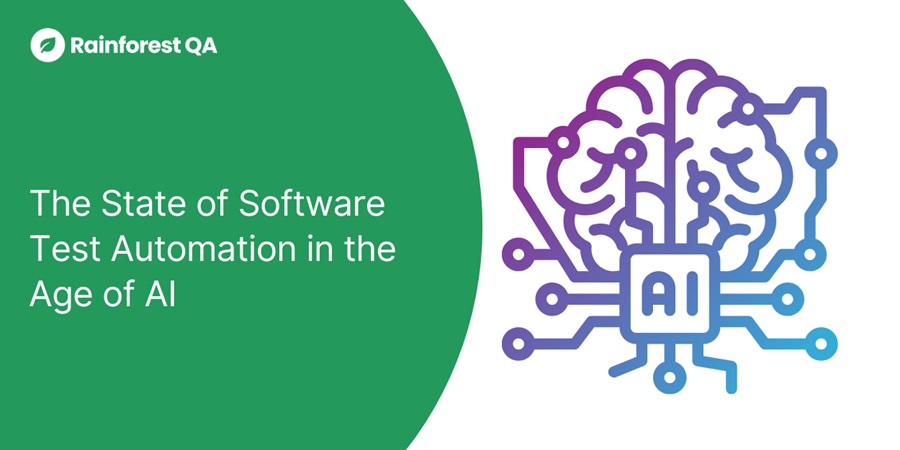LambdaTest announced the launch of the HyperExecute MCP Server, an enhancement to its AI-native test orchestration platform, HyperExecute.
The software testing landscape is undergoing a transformative shift, driven by emerging technologies and evolving development practices. Rainforest QA's survey of over 625 software engineering leaders from technology companies across the United States, Canada, the United Kingdom, and Australia reveals new insights into how development teams are approaching end-to-end (E2E) test automation in 2024.

Test Automation Takes Root Early
One of the most striking findings challenges the conventional wisdom about when startups begin investing in automated testing. Contrary to an assumption that early-stage companies delay implementation of robust testing, our research shows an early, proactive approach to test automation.
A full 55% of teams with only 1-5 developers automate their E2E tests, and this number jumps to 69% for teams with 6-10 developers. This early adoption reflects a growing understanding that maintaining product quality is crucial from the earliest stages of software development.
Adoption rates of test automation tend to grow as development teams do. But it's not a universal practice. Even among larger teams, 10-15% continue to rely entirely on manual testing. This can be due to different factors, including the type of product being tested. For example, video games and VR software aren't supported (or well-supported) by test automation, so the only recourse is manual testing.
The AI and Testing Paradox
Generative AI has made significant inroads, with 81% of respondents reporting AI usage in their software testing workflows. The technology's adoption is accompanied by growing confidence — 56% of respondents report increased trust in AI's accuracy compared to a year ago, with an average trust score of 8.1 out of 10.
However, the impact of AI is more complex than its adoption rates suggest. Despite high enthusiasm, AI hasn't yet delivered clear productivity gains for teams using open-source testing frameworks. In fact, open-source teams using AI for test creation and maintenance actually spend slightly more time on these tasks compared to those not using AI. This doesn't mean AI is ineffective; rather, it suggests the technology and its implementations are still evolving.
There are glimmers of promise, particularly for smaller teams. Those using AI for test maintenance are more likely to keep their automated test suites up to date — a critical challenge for resource-constrained development teams.
No-Code: A Game-Changing Alternative
Perhaps the most interesting insight is the emergence of no-code testing tools as a transformative approach to test automation. Teams using no-code platforms spend notably less time creating and maintaining automated tests compared to those wrestling with open-source frameworks.
The advantages are especially pronounced for smaller teams. Specifically, 93% of small teams using no-code tools successfully keep their test suites up to date, compared to just 75% of those using open source. Plus, only 10% of small teams using no-code spent more than 20 hours per week on test maintenance, compared to 19% of teams using open-source frameworks.
This substantial difference highlights an opportunity for development teams who want to remove bottlenecks from their quality assurance processes and ship code faster.
Looking Ahead
The testing landscape is evolving at an unprecedented pace. While AI hasn't yet delivered on its full promise, its potential remains. Industry experts anticipate future tools will increasingly blend the intuitive interfaces of no-code platforms with AI's capabilities, creating more accessible and efficient testing solutions.
As software development continues to accelerate, how teams approach testing will be crucial in maintaining product quality, ensuring reliable releases, and maintaining competitiveness.
Industry News
Cloudflare announced Workers VPC and Workers VPC Private Link, new solutions that enable developers to build secure, global cross-cloud applications on Cloudflare Workers.
Nutrient announced a significant expansion of its cloud-based services, as well as a series of updates to its SDK products, aimed at enhancing the developer experience by allowing developers to build, scale, and innovate with less friction.
Check Point® Software Technologies Ltd.(link is external) announced that its Infinity Platform has been named the top-ranked AI-powered cyber security platform in the 2025 Miercom Assessment.
Orca Security announced the Orca Bitbucket App, a cloud-native seamless integration for scanning Bitbucket Repositories.
The Live API for Gemini models is now in Preview, enabling developers to start building and testing more robust, scalable applications with significantly higher rate limits.
Backslash Security(link is external) announced significant adoption of the Backslash App Graph, the industry’s first dynamic digital twin for application code.
SmartBear launched API Hub for Test, a new capability within the company’s API Hub, powered by Swagger.
Akamai Technologies introduced App & API Protector Hybrid.
Veracode has been granted a United States patent for its generative artificial intelligence security tool, Veracode Fix.
Zesty announced that its automated Kubernetes optimization platform, Kompass, now includes full pod scaling capabilities, with the addition of Vertical Pod Autoscaler (VPA) alongside the existing Horizontal Pod Autoscaler (HPA).
Check Point® Software Technologies Ltd.(link is external) has emerged as a leading player in Attack Surface Management (ASM) with its acquisition of Cyberint, as highlighted in the recent GigaOm Radar report.
GitHub announced the general availability of security campaigns with Copilot Autofix to help security and developer teams rapidly reduce security debt across their entire codebase.
DX and Spotify announced a partnership to help engineering organizations achieve higher returns on investment and business impact from their Spotify Portal for Backstage implementation.
Appfire announced its launch of the Appfire Cloud Advantage Alliance.













